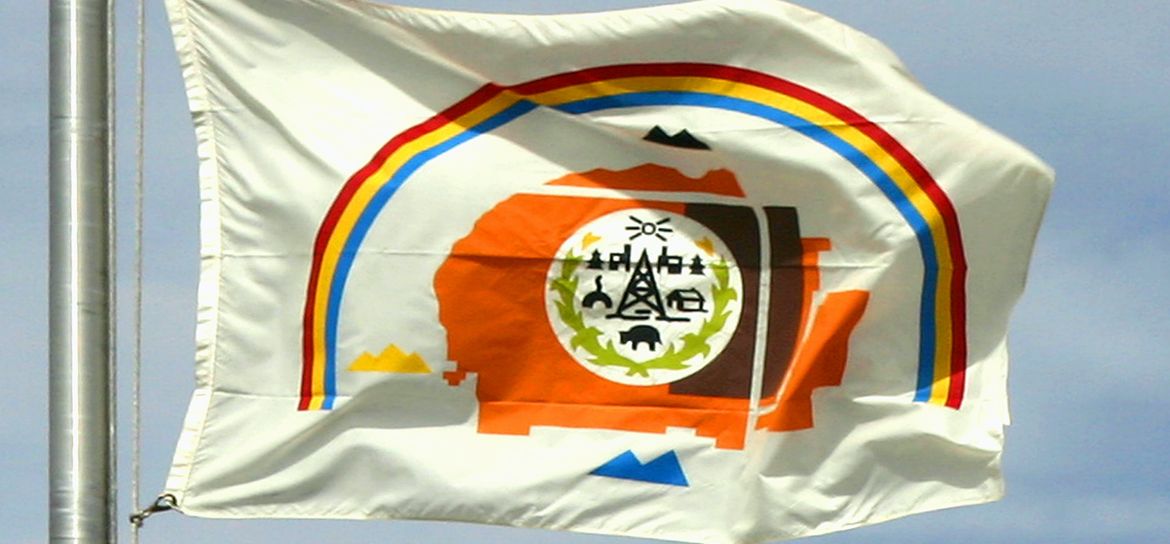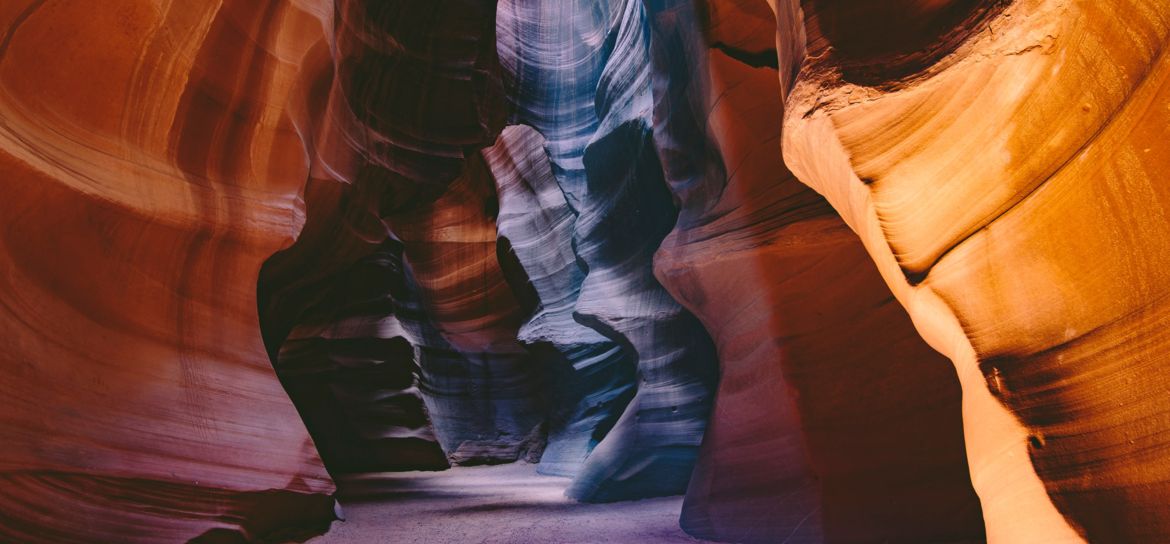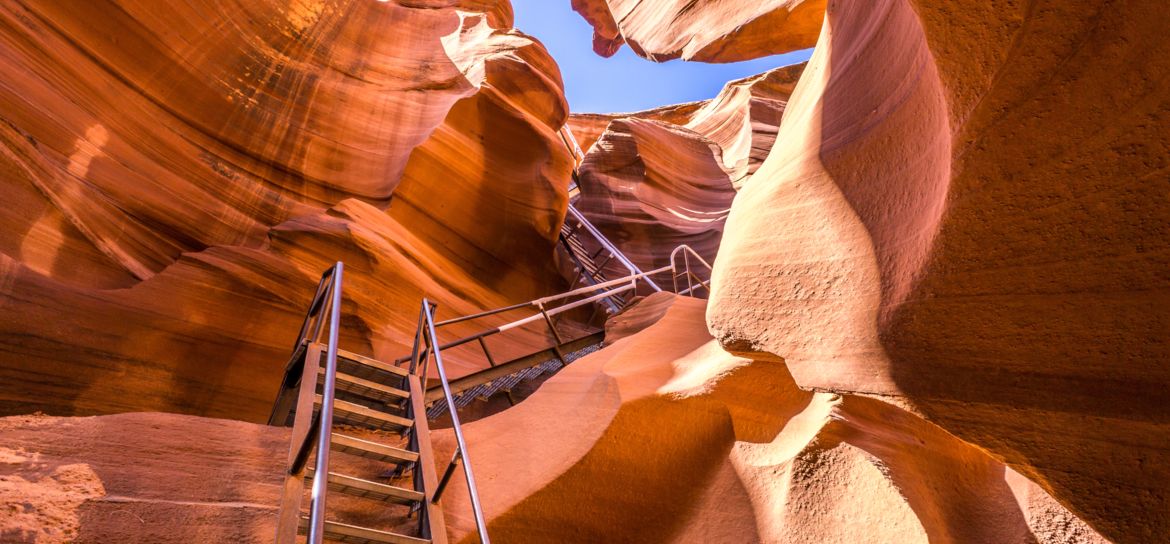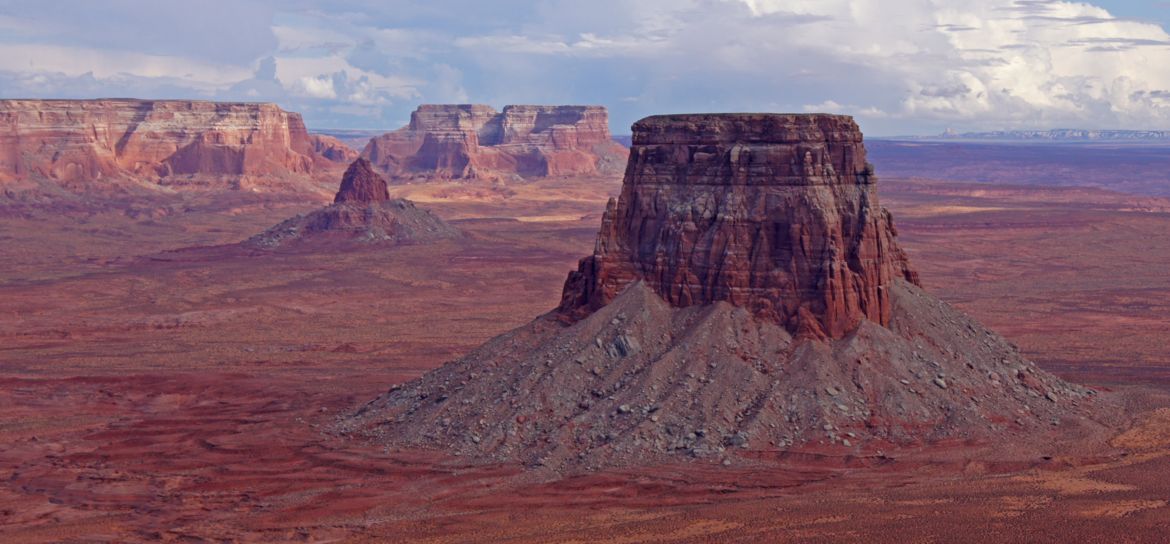
Guide To Visiting Antelope Canyon
Antelope Canyon is a world-famous slot canyon located just outside of Page, Arizona that attracts more than a million visitors each year. Explorers here can explore winding canyon corridors, massive sandstone rooms, and capture images of the photogenic beams of sunlight that radiate down to sandy floor.
If you're planning to visit Page, Arizona you can join an Antelope Canyon tour and see the beauty for yourself. You can also travel to Page on a day trip from Las Vegas or from the Grand Canyon National Park. Best of all, these flights include entry into Antelope Canyon!
If you've been dreaming of exploring Antelope Canyon, use this guide to learn everything you need to know about your visit and help plan your trip to this geological marvel.

Antelope Canyon Facts
- This ethereal canyon belongs to the Navajo Nation.
- The name Antelope Canyon comes from the once plentiful prong horned antelope that used to roam the area.
- Antelope Canyon displays a wide range of colors due to weathering and the presence of other minerals such as quartz sand and iron oxides.
- Rainwater, often in the form of monsoon season flash flooding, has cut narrow passageways, eroded corridors, and wave-like shapes in the rocks over the past 190 million years.
- Although it is one, 30-mile long slot canyon comprising four different sections, there are various points visitors can access to see this world-famous spot.
- Antelope Canyon was first opened for tours in 1983.
- In 1997, the Navajo Tribe made Antelope Canyon a Navajo Tribal Park it is now the primary attraction of Lake Powell Navajo Tribal Park.
- Navajo Nation Parks & Recreation oversees all Navajo Tribal Parks on the Navajo Nation Reservation. Its mission is to protect, preserve, and manage tribal parks, monuments and recreation areas for the perpetual enjoyment and benefit of the Navajo Nation.

Where Is Antelope Canyon?
Antelope Canyon is located 10 minutes east of Page, Arizona near the Arizona-Utah border. Most tours begin in Page or at the park's entrance off Highway 98.
Here are distances to Antelope Canyon from popular nearby destinations:
- Antelope Canyon from Phoenix - 275 miles
- Antelope Canyon from Las Vegas - 300 miles
- Antelope Canyon from Flagstaff - 130 miles
- Antelope Canyon from Grand Canyon South Rim - 135 miles
How to Get to Antelope Canyon
Las Vegas to Antelope Canyon
If you plan to drive from Las Vegas to Antelope Canyon, prepare for an approximate 4 hour 30 minute drive each way. If you'd like to reach your destination much faster, you can enjoy a day tour from Las Vegas to Antelope Canyon aboard a sightseeing airplane with a flight time of just 90 minutes each way! Best of all, entry into the canyon is included in your flight's price and ground transportation will shuttle you from the Page Municipal Airport to the canyon entry with an additional stop at Horseshoe Bend.
Grand Canyon to Antelope Canyon
The drive from the Grand Canyon National Park to Antelope Canyon is just under 2 hours. If you're visiting the Grand Canyon and would like to spend a day exploring Page, Arizona, you can fly from the South Rim to Antelope Canyon in just under an hour! You'll receive ground transport to Antelope Canyon, where a Navajo guide will lead your tour into its depths, and also visit Horseshoe Bend for photo opportunities.
Best Time To Visit Antelope Canyon
The most popular time to visit Antelope Canyon is spring or fall. In general, the weather is most pleasant between late March to early October. This time period offers the best season to capture similarly famous photos you have seen of this destination and avoids the intense summer heat.
But be prepared! More than 1 million visitors descend on Antelope Canyon each year and the narrow and confined attraction can be quite crowded.
If you are looking to avoid the peak crowd season, we recommend November, which can still bring fall-like temps, and February, which is a very beautiful month of gradual warming, cool mornings and nights, and the occasional cool rainstorm.

How Much Does It Cost To Enter Antelope Canyon?
You can only enter Antelope Canyon with an official tour group operated by the Navajo Nation. All areas of the Antelope Canyon are only accessible via guided tour operators that employ certified tour guides. The Navajo lead tours through both Upper and Lower Antelope Canyon, as well as the equally beautiful Secret Canyon nearby.
Guests are required to pay an entry fee that varies depending on the region of the canyon and details of the tour. Wondering if a trip to Antelope Canyon is within your budget? The prices Navajo tour companies charge vary depending on which region of Antelope Canyon you plan to visit, the tour's duration, and the ages of the persons in your group, as children are often discounted. General and photography tours are offered at both canyons, and general tours are cheaper and shorter than photography tours.
If you are traveling to Antelope Canyon from outside of Page, such as from Las Vegas or the Grand Canyon National Park, consider a flight that includes Antelope Canyon entry fees in the price to save both time and money!

Upper Antelope Canyon Tours
Upper Antelope Canyon is known as Tsé bighánílíní 'by the Navajo, which means 'the place where water runs through rocks.' The entrance and the entire length of Upper Antelope Canyon is at ground level, requiring no climbing, and contains several winding corridors and massive stone "rooms", as well as unique rock formations found throughout.
Upper Antelope Canyon tours last about 90 minutes and start times are usually available at times between 10:30 am and 1:30 pm. To take the best photographs at Upper Antelope Canyon, try to arrange your tour for a departure time around 10:30 AM. This is the prime opportunity to capture the famous sunbeams cutting through cracks and openings in the rock above you. Upper Antelope Canyon tour operators will guide you through the canyon and point out the best places to capture professional-looking photos.

Lower Antelope Canyon Tours
Lower Antelope Canyon is called Hazdistazí, or 'spiral rock arches' by the Navajo. Situated entirely below ground, Lower Antelope Canyon tours require guests to climb up and down a number of stairs along the hike and climb over a few boulders. It is a slightly longer and more difficult hike than Upper Antelope Canyon, about .5 miles each way, and the stone corridors are much narrower in many places along its length.
Lower Antelope Canyon tours last about 90 minutes are are available between 9:30 am and 12:30 pm. You can also book a photography-only tour within Lower Antelope Canyon around midday when the sunlight is at its peak.
If you plan to visit Lower Antelope Canyon from Las Vegas or on a day trip from the Grand Canyon National Park, you can maximize your exploration time with a short flight and included ground transportation to the canyon's entrance.
Secret Antelope Canyon Tours
If you are looking for a non-crowded alternative to the aforementioned Upper and Lower Antelope Canyon destinations, then Secret Antelope Canyon is for you. This canyon is also located right outside of Page, Arizona and contains similar colors and formation as the more popular locations.
If you visit Secret Antelope Canyon you will not be rushed or dealing with massive crowds. As an added bonus, these tours allow you to use a tripod for capturing longer explore photographs.
Overall, it's a much calmer experience and a true adventure to get to the mouth of the canyon.
Papillon offers tours to Antelope Canyon from Las Vegas that utilize guides from Horseshoe Bend Tours for a memorable trip to both Secret Antelope Canyon and a private Horseshoe Bend overlook.
Secret Antelope Canyon is also sometimes known as Horseshoe Bend Slot Canyon. This is due to its location which is across Highway 98, but down about 6 miles of gated and unmarked dirt roads, from Horseshoe Bend's main parking lot. You'll drive in an open-air 4x4 truck down the bumpy roads to the start of the excursion. Cover yourself as the trip is windy and sandy.

Tips for Visiting Antelope Canyon
Mid-day is the best time to capture photos of the dancing light shows that have made Antelope Canyon famous.
But, since this attraction is open year-round you can avoid the dense crowds if you avoid mid-day time slots during weekends.
The environment is sunny, warm, and dusty. Prepare accordingly by packing sunscreen, protection for your head and face, and to avoid dehydration, bring as much water as you can!
What To Bring To Antelope Canyon
It's recommended to bring the following items with you on your visit to Antelope Canyon:
- Water
- Snacks
- Sunglasses
- High SPF Sunscreen
- Hat or Bandana
- Camera equipment
What Not To Bring To Antelope Canyon
There are very clear and strict rules about what you can and cannot bring into Antelope Canyon due to its popularity and sacred nature for the Navajo Nation.
The following items are prohibited in Antelope Canyon:
- Tripods, monopods, and selfie sticks
- Go-pros or other video cameras
- Drones
- Backpacks or other large bags
- Open toed shoes, sandals, or shoes with heels
- Pets or service animals
- Firearms or any other weapons
- Smoking

Photography at Antelope Canyon
Photographers travel from around the globe to capture the delicate light show that takes place on Antelope Canyon's sandstone canyon walls. Beams of light sneak through the tight, twisted canyon openings to display a vibrant and dancing kaleidoscope of orange-gold.
Photography in Antelope Canyon can be tricky. The environment is very sandy, congested, and narrow. It is often windy and blowing dust is everywhere. If you have a DSLR camera, cover it when you are not using it and avoid changing lenses in this sandy, windy environment. For best results, use low film speeds or settings and turn off your camera flash.
Tripods, monopods, and selfie-sticks are prohibited to usewithin Antelope Canyon.

Antelope Canyon and the Navajo Nation
The most impressive natural landforms in Page, Arizona - including Tower Butte, Horseshoe Bend, Rainbow Bridge, and Antelope Canyon - are all within the property of the Navajo Nation. This reservation, the largest land area held by a Native American tribe in the U.S, is a massive 17.5 million acre chunk of land that includes portions of Arizona, Utah, and New Mexico.
Navajo land is sacred to its people. It is one of a few Indigenous nations whose reservation lands overlap its traditional homelands and has actually expanded since its establishment in 1868. Oral tradition states Navajo warriors would hide within the depths of Antelope Canyon while their adversaries rode across its inconspicuous surface unknowingly. Be sure to ask your Navajo guide for more information on the history of this special and historical place.
Navajo Nation Sights
Antelope Canyon isn't the only incredible natural landform found on the Navajo Nation's land. There's also Tower Butte, Horseshoe Bend, and Rainbow Bridge - all stunning rock formations within the Navajo territory, and Papillon can take you to see them! Learn more about these breathtaking landscapes near Page, Arizona.
Tower Butte
Like a massive skyscraper emerging from the desert earth, Tower Butte quite literally "towers" over its surroundings at an elevation of more than 5,000 feet. Visitors can only reach the top of this remarkable landmark aboard a Tower Butte helicopter tour. Tower Butte offers one of the widest views of the desert expanse, Lake Powell, and the distant city of Page, Arizona.
Horseshoe Bend
This world-famous twist in the Colorado River has been an inspiration for photographers and artists alike for decades. Here the river curves into nearly a full circle - a spectacular sight to those who make the journey to see it, whether by hiking on foot or flying over it on a Horseshoe Bend air tour.
Rainbow Bridge
Rainbow Bridge is the world's largest natural stone bridge, formed by thousands of years of wind and water erosion. This near-perfect arch rests on Navajo land and has been considered sacred by the Navajo tribe for centuries. To reach Rainbow Bridge, one must hike 14 miles through rugged Navajo land with a permit from the Navajo people.
Book With Papillon Today!
If you're dreaming of experiencing Antelope Canyon, Papillon can take you there! We offer tours of Antelope Canyon from Las Vegas, as well as daily departures from the Grand Canyon National Park to Page AZ, and we highly recommend making the time to visit this truly otherworldly destination during your vacation. Book a tour today and experience the majesty of the Navajo Nation's world-famous landmarks!